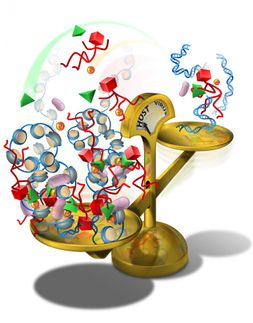Relationships inside a cell
Scientists publish the first RNA interactome of the human nucleus
Advertisement
Studying sequence and function of DNA has been in the focus of life sciences for decades, but now the interest of many researchers has turned to the RNA. Today, many scientists believe that RNA molecules, together with a variety of different proteins, play a regulatory or structural role in virtually all cellular processes. However, the mechanisms underlying these RNA-protein interactions are still largely unknown. A team of scientists from the Max Planck Institute for Molecular Genetics in Berlin has now successfully identified hundreds of proteins that interact with RNA molecules in the nucleus of human cells. The researchers present the first RNA interactome of a human nucleus and describe how they have identified the bulk of RNA-binding proteins in the nucleus of human cells, using their newly developed method of "serial RNA interactome capturing".
For decades, proteins have been regarded as the main functional components in living cells. However, in recent years their paramount importance for cellular processes has been rivaled by the growing knowledge about the involvement of RNA molecules. RNA in the shape of messenger RNA (mRNA) and transfer RNA (tRNA) has been believed to act as a mere mediator between the DNA, carrying the genetic information, and the proteins, being the building blocks of the cell. But for a few years it has been shown now, that in addition to being a messenger for the genomic information, the RNA mediates several other functions. These non-coding functions of RNA include tasks in the regulation of gene transcription and protein production as well as the determination of the positions of other molecules within the cell. Elucidating the interplay between proteins and RNA has therefore become crucial for understanding the molecular mechanisms of the development of organisms and the emergence of diseases.
A research group headed by Ulf Andersson Ørom at the Max Planck Institute for Molecular Genetics in Berlin has now for the first time created an overview of the numerous interactions between RNA molecules and proteins in a human nucleus. For this, the scientists had to modify the “RNA interactome capture technique” for analyzing RNA-protein interactions at first, so that they could use it to identify the RNA-protein interactions inside specific compartments of the cell, e.g., the nucleus. With the modified method, the researchers investigated the nuclei of a total of one billion cells in order to capture and catalogue all possible RNA-protein interactions in the nucleus.
“It has been particularly interesting for us that many of the discovered RNA-binding proteins do not only control the activity of genes and the fate of the resulting RNA molecules, but are also involved in the detection and repair of damaged DNA”, Ørom explains. DNA damage such as false or missing bases or breakage of one or both strands of the DNA double helix can occur as a consequence of reactive oxygen species, UV-radiation or other external or internal stimuli. DNA-damage occurs thousands of times each day within every cell in the body. The cell responds with a complex repair process involving numerous proteins and RNA molecules that specifically repair damaged DNA, thus maintaining the functionality of the cell.
“A role for RNA in the repair of damaged DNA has been suspected for some time, but how RNA can impact on this process has remained unknown”, says Ørom. “By identifying the protein factors that link RNA to the DNA damage response, this study contributes to a better understanding of these mechanisms.” The scientists hope that their findings will contribute to a better understanding of the emergence of human diseases and the development of new therapies against cancer.



























































